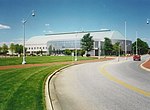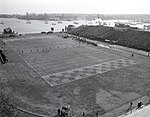Sparrow's Beach
African-American history in Annapolis, MarylandAnnapolis, MarylandHistoric sites in Maryland
Sparrow's Beach was a beachfront resort on the Chesapeake Bay that catered to African American patrons during segregation in the American South.Located just south of Annapolis, Maryland, Sparrow's Beach was established as a recreational area during the Jim Crow-era when African-Americans were denied entry into 'Whites-only' establishments. Other nearby beachfront resorts used for this purpose included Carr's Beach, Elktonia Beach, Bembe Beach, Highland Beach, Venice Beach, Oyster Harbor, and Arundel-on-the-Bay.In August 2022, the City of Annapolis purchased what remains of Sparrow's Beach, Carr's Beach, and Elktonia Beach to preserve the land as a park.
Excerpt from the Wikipedia article Sparrow's Beach (License: CC BY-SA 3.0, Authors).Sparrow's Beach
Chesapeake Harbour Drive, Annapolis
Geographical coordinates (GPS) Address Nearby Places Show on map
Geographical coordinates (GPS)
| Latitude | Longitude |
|---|---|
| N 38.95865 ° | E -76.47251 ° |
Address
Chesapeake Harbour Drive 2185
21403 Annapolis
Maryland, United States
Open on Google Maps







